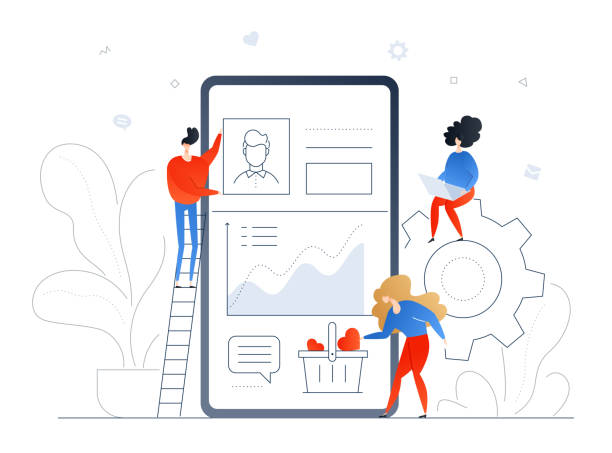Introduction to the Importance of Secure Website Design in Today’s Digital World

In the current era, where the internet has become the primary platform for interactions, commerce, and information dissemination, the topic of #Website_Security has become more critical than ever.
A secure website not only protects user information and your business’s sensitive data, but also builds public trust and enhances your digital credibility.
Secure website design is no longer a luxury option, but an undeniable necessity for every business and individual aiming for an effective and sustainable online presence.
Ignoring security measures can lead to major disasters, including data theft, data loss, cyberattacks, and irreparable damage to brand reputation.
Today, awareness of the fundamental principles of web security is of paramount importance for developers and website administrators. This section, in an explanatory and educational manner, helps you gain a better understanding of the challenges and solutions available in this field.
From common attacks to preventive methods, every step towards securing an online platform can make a significant difference.
The main goal of this article is to provide a comprehensive and practical guide to help you in securing your site and protecting your digital assets.
Data protection and ensuring service stability are considered key pillars of success in the online space.
The content of this section is designed to be thought-provoking and encourage you to consider various aspects of web security.
How can we protect sensitive information from cyber attackers? What measures should we take to prevent attacks? These are questions whose answers form the foundation of a secure website design.
By investing appropriately in this area, you can protect your business against increasing threats and provide a secure and reliable experience for your users.
Remember that security is an ongoing process, not a final destination.
Did you know that your website is the first impression customers have of your company? With a powerful corporate website from Rasavab, multiply your business’s credibility!
✅ Custom and eye-catching design tailored to your brand
✅ Improved user experience and increased customer acquisition
⚡ Get a free consultation!
Understanding Common Web Threats and Methods for Identifying Them

Understanding #Cyber_Threats is the first step towards secure website design.
Without a proper understanding of how attackers operate, effective defense will not be possible.
Attacks such as SQL Injection, Cross-Site Scripting (XSS), Cross-Site Request Forgery (CSRF), and Distributed Denial of Service (DDoS) attacks are among the most common threats targeting websites.
Each of these attacks exploits specific weaknesses in the website’s structure or coding.
For example, in an SQL Injection attack, the attacker attempts to gain access to the database by injecting malicious SQL code into form inputs.
This section provides a specialized and guided explanation of these attacks.
To identify these threats, the use of #Security_Scanning tools and regular penetration tests is essential.
These tools can identify known vulnerabilities in your code or server configuration.
Furthermore, continuous monitoring of server logs and security software can reveal early signs of attacks.
Remember that attackers are constantly devising new methods, so keeping your knowledge of threats up-to-date is critically important.
This is an analytical content that helps you adopt a proactive approach against attacks and move towards secure website design.
In addition to technical attacks, threats such as phishing and social engineering can also jeopardize your website’s security.
These attacks often target users and obtain sensitive information by deceiving them.
Educating users and employees about these types of threats is an integral part of a comprehensive #Online_Platform_Security strategy.
Collective awareness and vigilance are the backbone of resistance against these attacks.
A deep understanding of these threats will pave the way for securing your online platform and help you make more informed decisions for secure website design.
Best Practices for Secure Coding and Development to Ensure Website Security

The foundation of any secure website design is coding and development with a security-by-design approach.
From the very beginning of the project, security principles must be integrated into all stages of the Software Development Life Cycle (SDLC).
Using reputable and up-to-date libraries and frameworks, thorough input validation to prevent injection attacks, and output encoding to prevent XSS attacks are among the vital measures.
Also, using Prepared Statements in database queries is the best way to combat SQL Injection.
Proper error handling and security logging are also of great importance.
Sensitive information should not be displayed in error messages, and logs should be regularly monitored to detect suspicious activities.
Regularly updating all components, libraries, and Content Management Systems (CMS) is also a vital step in maintaining website security.
This section provides specialized guidance to help you in this regard.
To better understand secure coding concepts and best practices in site hardening, the following table illustrates some key principles:
| Security Principle | Description | Application in Secure Website Design |
|---|---|---|
| Input Validation | Checking and sanitizing all user input data | Prevention of SQL Injection and XSS attacks |
| Principle of Least Privilege | Access to resources only as needed by users/systems | Limiting the scope of damage in case of breach |
| Secure Session Management | Generating strong session tokens, regular token expiration | Protection against session hijacking |
These methods form the cornerstone of a comprehensive approach to secure website design, and adhering to them not only protects your website but also helps improve its overall performance.
The Role of SSL/TLS Certificates and HTTPS Protocol in Web Security

One of the most fundamental steps towards secure website design is the implementation of SSL/TLS certificates and the use of the HTTPS protocol.
#HTTPS_Protocol is a secure version of the HTTP protocol that encrypts the communication between the user’s browser and the website server using SSL/TLS encryption.
This encryption ensures that exchanged data, including personal information, passwords, and credit card details, remain safe from unauthorized access during transmission.
Installing a valid SSL/TLS certificate not only builds user trust (by displaying a lock icon in the browser’s address bar) but is also important for SEO.
Search engines like Google prefer HTTPS-enabled websites in search results rankings.
This is an explanatory and guiding section that helps you understand the importance of this step.
There are various types of SSL/TLS certificates, including Domain Validated (DV), Organization Validated (OV), and Extended Validation (EV).
Each of these certificates offers a different level of identity verification.
For a secure website design, at least using a DV certificate is recommended, but for commercial websites that process sensitive information, OV or EV certificates provide higher security and trust.
In fact, digital certificates form the backbone of #Online_Platform_Security.
Ensuring correct SSL/TLS configuration is also crucial.
Using older, vulnerable protocols (such as TLS 1.0 or SSLv3) or weak encryption algorithms can compromise communication security.
Keeping server configuration and certificates up-to-date is an integral part of the site hardening strategy and directly impacts your website’s credibility and reliability.
A secure website design is not complete without HTTPS.
Are you losing business opportunities because of an outdated website? With Rasavab, permanently solve the problem of not attracting potential customers through your website!
✅ Attract more high-quality leads
✅ Increase brand credibility in the eyes of customers
⚡ Get a free corporate website design consultation
Database Security and Protection of Sensitive Information

The database is the heart of any website, containing vital information.
Therefore, #Database_Security is considered an integral component of secure website design.
From encrypting data at rest and in transit, to strict access control and activity monitoring, every step is crucial for protecting this valuable resource.
Applying the Principle of Least Privilege for database users, meaning each user only has access to the data required for their tasks, is a key principle.
Other essential steps for #Data_Protection include regularly updating the Database Management System (DBMS), applying security patches, and disabling unnecessary features that could create potential vulnerabilities.
Furthermore, regular and encrypted backups of the database, stored in a secure and separate location, are essential for data recovery in case of an incident.
This section is presented in a specialized and guiding manner.
One of the most important aspects of securing an online platform is the encryption of sensitive information such as user passwords.
Passwords should never be stored as plain text in the database; instead, they should be stored using strong hashing algorithms along with “Salt” to be resistant against brute-force and dictionary attacks.
This is specialized content that helps increase your data security.
Continuous monitoring of database activities to identify unusual access patterns or attempted intrusions is also of great importance. Intrusion Detection Systems (IDS) and Intrusion Prevention Systems (IPS) can be helpful in this regard.
Correct implementation of these measures provides the cornerstone of a secure website design and protects your valuable data against threats.
The Importance of User Authentication and Access Management

The security of a website heavily depends on its #Authentication_System and user access management.
Secure website design involves implementing strong mechanisms for verifying user identity and controlling their access to various resources.
Using strong passwords and policies that enforce periodic changes is the first step.
But this alone is not enough.
Two-Factor Authentication (2FA) or Multi-Factor Authentication (MFA) is highly recommended.
These methods, by adding another layer of security beyond the password (such as a code sent to a mobile phone or using authentication apps), protect user accounts even if the password is compromised.
This is guiding and explanatory content.
In addition to authentication, Access Management is also vital.
This includes precisely defining roles and permissions for each user and ensuring that users only have access to the parts of the website they need to perform their tasks.
This concept is known as the “Principle of Least Privilege.”
Regular review of access permissions, especially when roles change or employees leave, is essential for maintaining website security.
Furthermore, account lockout mechanisms after several failed login attempts can prevent brute-force attacks. Monitoring login activities and logging them to identify suspicious patterns is also an important part of #Online_Platform_Security.
By strongly implementing these mechanisms, a secure website design can effectively protect your data and systems.
These steps are essential for any website, from a personal blog to a large e-commerce platform.
Penetration Testing, Security Audits, and Continuous Updates

After initial implementation, secure website design is not a static process; rather, it requires continuous attention and updates.
#Penetration_Testing and Security Audits are vital tools for identifying vulnerabilities that may arise over time or with changes in code and infrastructure.
Penetration testing involves simulating controlled cyberattacks by security professionals to identify potential weaknesses before real attackers discover them.
Security audits are more comprehensive reviews that include not only technical aspects but also security procedures and policies.
These audits can help identify configuration flaws, logical vulnerabilities in the business, and weaknesses in security policies.
The results of these tests and audits provide valuable information for the continuous improvement of #Online_Platform_Security.
This is analytical and specialized content.
Continuous updates are also of great importance.
All software, from server operating systems and web servers to programming languages, frameworks, libraries, and plugins used, must be regularly updated.
Many cyberattacks occur due to the exploitation of known vulnerabilities in older software versions.
To better organize the testing and updating process within the framework of a secure website design, the following table can be useful:
| Activity Type | Description | Importance for Secure Website Design |
|---|---|---|
| Penetration Testing | Simulating attacks to find vulnerabilities | Discovering hidden weaknesses before attackers |
| Security Audit | Comprehensive review of security policies and procedures | Ensuring compliance and comprehensive security coverage |
| Software Updates | Applying security patches and upgrading components | Fixing known vulnerabilities and strengthening defenses |
A regular schedule for these activities significantly helps in continuously maintaining and strengthening your website’s security.
Disaster Recovery Planning and Security Incident Response
![]()
Even with the best secure website design approaches, the possibility of security incidents is not completely eliminated.
Therefore, having a well-defined #Disaster_Recovery_Plan (DRP) and #Incident_Response_Plan (IRP) is crucial.
These plans help you react quickly and effectively to minimize negative impacts in the event of cyberattacks, system failures, or data loss.
The disaster recovery plan includes steps for recovering systems and data after a serious incident.
This includes taking regular and tested backups, defining Recovery Time Objectives (RTO) and Recovery Point Objectives (RPO), and having procedures for restoring systems to an operational state.
This process should be regularly practiced and updated.
The incident response plan provides step-by-step procedures for identifying, containment, eradication, recovery, and post-incident analysis of a security event.
The Computer Security Incident Response Team (CSIRT) must have clear responsibilities, and internal and external communication procedures must be defined.
The primary goal is to minimize downtime and data loss.
This is specialized and guiding content that helps administrators and developers prepare for worst-case scenarios.
Having these plans not only helps increase the website’s resilience against threats but also accelerates recovery after an incident and protects the business’s reputation.
Part of securing an online platform is being prepared for when security is compromised.
In general, secure website design not only means preventing intrusion but also includes the ability to recover and resist attacks.
Investing in these plans will guarantee the stability and longevity of your website.
Are you concerned about your e-commerce site’s low conversion rate and not achieving your desired sales?
Rasavab is your specialized solution for a successful e-commerce website.
✅ Significant increase in conversion rates and sales
✅ Professional and user-friendly design to ensure customer satisfaction
⚡ Ready for an online sales transformation? Get a free consultation!
The Human Element in Web Security: Education and Awareness

In any secure website design strategy, the human element plays a vital role and is sometimes the most vulnerable link in the security chain.
Attackers often target individuals to gain access to systems through social engineering or phishing.
Therefore, #User_Education and raising their awareness about common threats and best security practices are of particular importance.
This is educational and engaging content.
Awareness should include training on identifying phishing emails, the importance of using strong and unique passwords, the dangers of clicking on suspicious links, and protecting personal information.
These trainings should not be one-off; rather, they should be updated regularly and in response to new threats.
For employees and developers, more specialized training in #Secure_Coding, proper access management, and incident response procedures is essential.
Everyone interacting with website systems must understand their responsibility in maintaining security. Creating a security culture within the organization, where security is a shared responsibility rather than solely an IT department task, is key.
Thought-provoking content in this area can include examining scenarios where a small human error can escalate into a major security incident.
How can a wrong click lead to unauthorized data access? These questions highlight the importance of awareness.
A website is only as secure as its users and administrators are aware and vigilant.
Remember that securing an online platform depends not only on technology but also on the behavior and knowledge of individuals.
Investing in education and awareness is one of the most effective investments towards a secure and sustainable website design.
Cloud Security and its Benefits in Secure Website Design

With the increasing use of cloud services, #Cloud_Security has become a critical aspect of secure website design.
Many websites and applications are now hosted on cloud platforms such as AWS, Google Cloud, or Microsoft Azure.
Although cloud service providers are responsible for the security of the infrastructure (security of the clouds), the responsibility for the security of data and applications on the clouds (security in the clouds) rests with the end-user.
The security benefits of using a cloud environment include high scalability, increased redundancy and reliability, and access to advanced security specialists from cloud providers.
These platforms typically feature built-in security tools such as advanced firewalls, intrusion detection and prevention systems, and Identity and Access Management (IAM), which significantly contribute to online platform security.
This is explanatory and analytical content.
However, there are also specific security challenges in the cloud environment, including misconfigured services, improper access management, and failure to comply with data privacy.
For a secure website design in a cloud environment, it is essential to understand the cloud provider’s Shared Responsibility Model and fulfill your own responsibilities correctly. This includes secure configuration of Security Groups, management of passwords and API keys, and encryption of data at rest and in transit.
Furthermore, using Cloud Security Posture Management (CSPM) tools can help identify and rectify misconfigurations that could lead to vulnerabilities.
With an intelligent approach to #Cloud_Security, one can leverage the benefits of these platforms while maintaining a high level of secure website design.
This section, as news and specialized content, helps you choose the appropriate platform.
Frequently Asked Questions
| Question | Answer |
|---|---|
| 1. What does secure website design mean? | Secure website design means creating a website that is resilient to cyberattacks and protects user and server information. |
| 2. Why is security important in website design? | To prevent data breaches, protect user privacy, maintain user trust, and avoid financial and reputational losses. |
| 3. What are the most common web vulnerabilities? | SQL Injection, Cross-Site Scripting (XSS), Cross-Site Request Forgery (CSRF), Broken Authentication, and Security Misconfiguration. |
| 4. How can SQL Injection be prevented? | By using Prepared Statements / Parameterized Queries, ORMs, and Input Validation. |
| 5. What is the role of HTTPS and SSL/TLS in site security? | HTTPS encrypts the communication between the user’s browser and the server using the SSL/TLS protocol, preventing eavesdropping and data tampering. |
| 6. What measures should be taken to prevent XSS attacks? | Input Validation, Output Encoding to prevent malicious code execution, and using Content Security Policy (CSP). |
| 7. What does a strong password policy include? | Mandating the use of long passwords, a combination of uppercase and lowercase letters, numbers, and special characters, and preventing reuse. |
| 8. How does Two-Factor Authentication (2FA) help security? | Even if a user’s password is compromised, the attacker cannot access the account without access to the second authentication factor (such as an SMS code or an app). |
| 9. What is a Web Application Firewall (WAF) and what is its use? | A WAF is a firewall that monitors and filters HTTP traffic between a web application and the internet to prevent common web attacks such as SQL injection and XSS. |
| 10. Why is regular updating of software and libraries important? | Updates often include security patches to fix discovered vulnerabilities. Failing to update can expose the site to new attacks. |
And Other Services of Rasavab Advertising Agency in the Field of Advertising
Intelligent Sales Automation: Professional optimization to increase click-through rates using key page optimization.
Intelligent Data Analysis: A professional solution to improve SEO ranking with a focus on intelligent data analysis.
Intelligent Sales Automation: A specialized service for digital branding growth based on precise target audience targeting.
Intelligent Advertising Campaign: A blend of creativity and technology for customer acquisition through marketing automation.
Intelligent Customer Journey Map: A fast and efficient solution to increase sales with a focus on custom programming.
And over a hundred other services in the field of internet advertising, advertising consultation, and organizational solutions
Internet Advertising | Advertising Strategy | Advertorials
Resources
Comprehensive Website Security Guide
Protecting User Information on Websites
Best Practices for Website Security
Key Tips for Secure Website Design
? For your business to soar in the digital world and achieve unprecedented success, Rasavab Afarin Digital Marketing Agency is by your side with its expertise and experience. From user-friendly website design and SEO optimization to executing targeted advertising campaigns, we are ready to transform your brand in the online space and pave the way for sustainable growth.
For consultation and services, contact us.
📍 Tehran, Mirdamad St., next to Central Bank, Kazeroon Jonubi Alley, Ramin Alley No. 6

